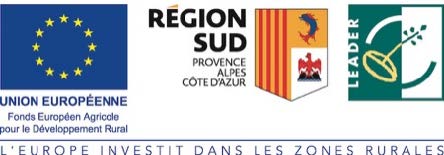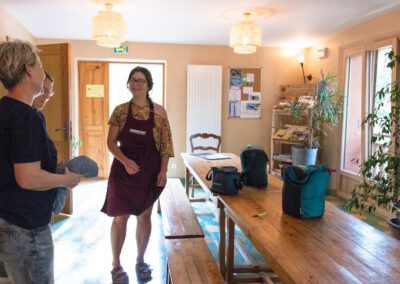Notre équipe est là pour répondre à toutes vos questions:

- Why hike in the Mercantour National Park?
- What is the climate in the Mercantour National Park?
- Why choose a small local agency?
- What does ecotourism mean?
- What kind of hike to choose?
- How to choose the level of difficulty of a circuit?
- What does hiking in freedom mean?
- How are the accommodations?
- Don’t we risk getting lost?
- How’s the donkey ride?
- How does hiking with a donkey differ from other hikes?
- Will there be a personalized welcome?
- How is a donkey handled?
- How to treat your donkey?
- How to pack your stuff on the donkey?
- Isn’t it difficult to leave for a week with children?
Why hike in the Mercantour?

The Mercantour, backed by Italy, has extraordinary geology and shares a common border with Piedmont. This region of the Southern Alps offers a unique landscape, plunging steeply into the Mediterranean about twenty kilometers as the crow flies. This proximity explains a temperate climate, softened by the maritime influence, combining sea and mountain in an exceptional way.
Six valleys, peaks are higher than 3000 meters, glacial lakes of an azure blue, an exceptional fauna with 153 species of birds make the Mercantour a « European jungle ». Northern Europeans call this region the “wilderness”. The trails infiltrate through panoramic alpine pastures and forests of flamboyant (larch?), especially in our secret valley « the high valley of the Var », which can be found to the far west of Mercantour, bordering the valley of Haut Verdon.
Our ascent to the sources of the Var and the Col de la Cayolle offers a unique experience of very varied and unusual landscapes. The Var is an atypical river because it does not flow in the department bearing its name but in the Alpes Maritimes. The Mercantour is inhabited by enthusiasts such as guides, shepherds, farmers, park wardens, state officials, instructors of all types during the seasons, and in the ski resorts, and its locales can be found all year round.
There are several ways to reach the south-east region of France, via train to the main station or by plane to Nice airport. The region benefits from efficient means of transport to go up the valley, such as regular buses or the picturesque railway line of Provence, also called « train des pignes », connecting Nice to Digne. The routes go through villages showing most of the backcountry of the region.
The Mercantour National Park, as a protected area, raises crucial questions about the protection of natural areas. Environmental thinking is essential to define the role of these national parks in the future of our planet.
As for the possibility of encountering a wolf at the turn of a trail, although this question is frequently asked, the answer is, however, negative. Wolves generally avoid human presence, and encounters are rare. The efforts of Cedric Robion, a specialist on the matter, wildlife photographer and guide, allow us to have a better understanding of these magnificent creatures.
« Hiking into the wild «
going for a week in this magnificent wilderness offers a unique opportunity in France. This is where you can be immersed in what is called « silting ». Which also answers the question, »why the Mercantour ».
What is the climate of the Mercantour National Park?
The climate of Mercantour, at the crossroads of a Mediterranean influence, is ideal for hiking. The temperatures are moderate, without prolonged rainy episodes in summer, except during thunderstorms in the mountains. Hikers must be properly equipped, with rain capes and waterproof walking shoes, to ensure the success of a week outdoors. Do not forget to bring a swimsuit: it does not take up space in the backpack and there are a variety of amazing swimming spots in rivers, lakes and lagoons all allowing you to refresh each day.
Why go with a small local agency

The Itinerance team, made up of mountain guides and professionals, nature lovers and children that have grown up in the region, travelers and ski instructors, who are each and everyone professional and motivated. This small local agency, founded almost 40 years ago, offers a rich and secure experience. The mountain guides, all holders of professional certificates for hiking and guiding, are passionate about where they will be taking you and will help you to discover the mountain and its unique environment, with the fauna, flora, history and heritage, as well as the more human environments. Their three-year training prepares them to guide and supervise groups in the mountains safely, while responding to new customer requests and requirements along with be good teachers.
What does “ecotourism” mean?

We modestly aspire to alternative tourism, avoiding big statements. Our commitment to ecotourism initiatives, such as the Green Key and the Esprit Parc network, demonstrates our consistency in addressing environmental challenges.
Diversity of tourism approaches:
Different forms of tourism are presented: responsible, green, sustainable, ecotourism, agritourism, fair, solidarity. The need to become ethical consumers is underlined with every step.
Responsible and sustainable tourism:
Beyond mass tourism, responsible tourism requires thinking about the expected growth of travelers. Introducing a code of conduct for long-term environmental practices is recommended.
Concrete examples of sustainable tourism:
The popular hike around Allos Lake is under discussion, highlighting overcrowding and the question of sacrificing a place for the benefit of others less frequented.
Ecotourism:
Ecotourism, often overused, is defined as a responsible hike minimizing impacts. Modest accommodation is highlighted as an alternative to 5-star hotels.
Slow tourism:
Slow tourism, a deceleration as opposed to the usual fast pace of our society, is introduced here. The emphasis is on the peaceful contemplation and exploration of the landscapes, as opposed to fast and high speed sports.
Reflection on slow tourism:
Taking time on vacation allows you to think about the tourist choices you are making. Slow tourism offers holidays far from controversial standards, highlighting a desire and a conviction of change in both actions and attitudes.

How to choose your hike?

Anita is available on the phone to help and advise you. Opting for a local agency like ours has the advantage of having circuits designed by us, adapted to your expectations and abilities. In 40 years of experience, we have diversified our itineraries to accommodate hikers of all different levels, from the everyday person to sportsmen, also on offer is the »idleness »option for those who prefer to take small hikes around our ecolodge.
We offer all kinds of accommodation such as: star hikes, roaming, small hotels, homestays, gites, inns and refuges. The choice and style of the hike depends on your personal preferences, and we one again will be happy to help and advise you.
How to choose the level of difficulty of a circuit?
Hiking is an outdoor activity, not a forced march. We guide you according to your experience, and real abilities, giving important advice to beginners and useful information for the more experienced hikers, such as summits to climb or ideal places to picnic.
Is it possible to hike without previous experience? Absolutely! We simply recommend a regular walk before departure, about 1 hour a day as preventive training, to accustom your feet and calves.
Need help on the spot?
We provide a hotline to guide you when needed, emphasizing that hiking in wilderness requires a sense of initiative and a certain experience of the mountain.
Route adaptations:
If one of our hikes interests you but requires adjustments, contact us. We are flexible and will adapt the itinerary according to your preferences and needs.
What is hiking freedom?

These are self-guided hikes:
We offer free-roaming hikes, ideal for those who prefer to travel individually, at their own pace, without a guide, to explore the Southern Alps. The varied circuits of the Mercantour National Park are aimed at mountain hiking enthusiasts, offering sports or contemplative options, adapted to each level.
We guarantee a carefree experience because we organize your accommodation and refueling, luggage transport every day, either by car and or along the hiking route. As passionate mountain guides, our job is to create logical and panoramic routes, exploring the most beautiful places in the Mercantour Alps.
What is the « itinerant hike »?
You’ll change accommodation every day (hostel, lodging, hotel or refuge) with the choice between two circuits, one easier, the other more intense.
In the semi-itinerant variant, you’ll change accommodation less frequently, with transfers organized when necessary: Links between two stages or and full repatriation at the end of the journey.
Star hikes:
Unlike touring, this contemplative package is perfect for those who prefer shorter walks. Ideal for lovers of idleness, botanists, geologists or entomologists, this option offers quality accommodation in our new ecolodge, with the possibility of sleeping in a yurt in the countryside above the gorges of Daluis, nicknamed the « Colorado Niçois ».
Who carries the luggage?
You’ll hike with a light back, your luggage being transported by car from step to step. You can also choose one of our donkeys to carry your luggage.
What are the risks of getting lost?


Trail Safety:
Thanks to the well-marked trail network developed by the Alpes Maritimes General Council, our routes are perfectly signposted. In forty years, no hiker has strayed. Every spring, we revise and re-mark the trails, guaranteeing a clear and unsurprising route for average hikers and those accompanied by donkeys.
Detailed preparation:
You will receive a detailed logbook with IGN top 25 maps and a local heritage information booklet. We keep a close eye on the mountain weather, adapting the routes according to the conditions. In case of intense heat, high altitude routes are recommended, and in case of risk of thunderstorms, early departures and retreat routes are suggested.
Mapping and training:
For novices, we provide basic notions on cartography before departure. The TOP25 series (1:25 000e) of the National Geographical Institute and the Department ensures maximum precision. Our seasonal recognitions ensure that the markings are always in place, therefore reducing any risk of getting lost.
What is the accommodation like ?
GITE ET YURTS DE VILLEPLANE : Night 1 for all tours:
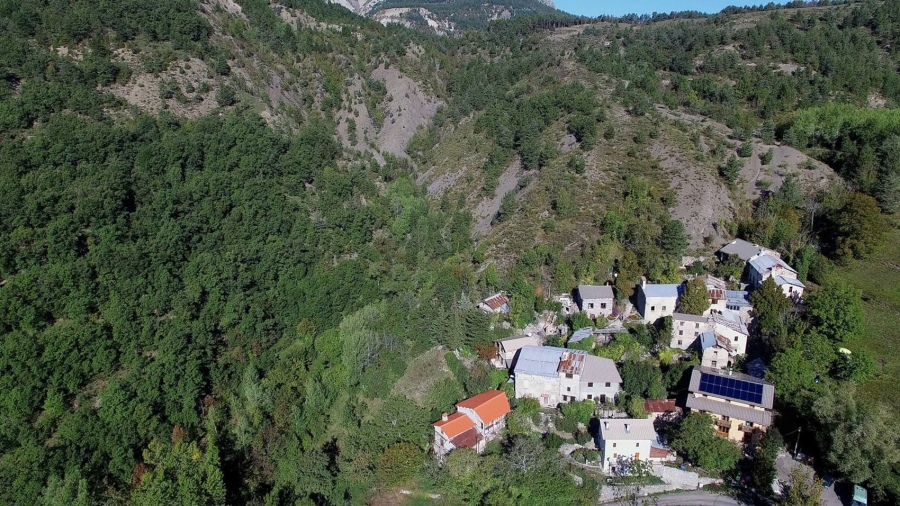
The charming hamlet of Villeplane, perched above the gorges of Daluis, is home to the ecogîte Villeplane, an ecological building low in consumption. Solar panels and wood heating ensure a comfortable stay in this green setting.





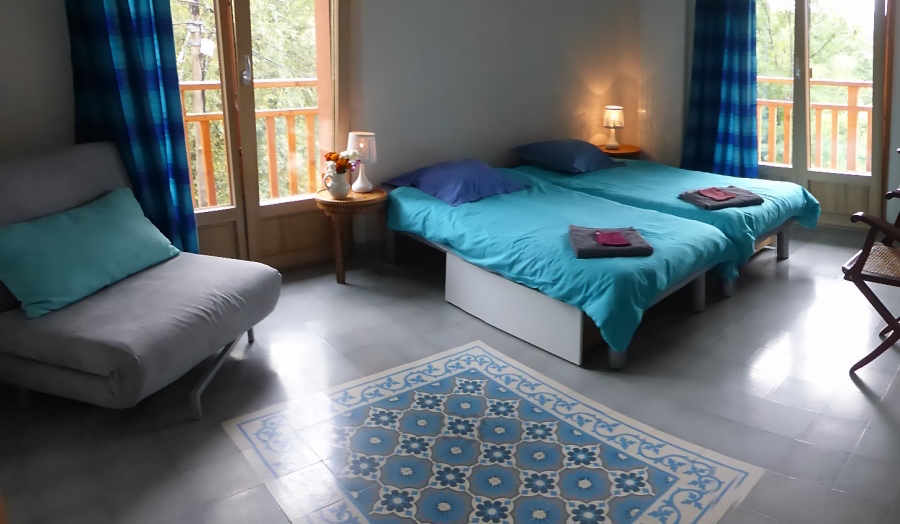
Modern Yurt

Compared to the traditional Mongolian yurt, the contemporary yurt offers a different charm, combining modernity and comfort. With its skydome, it allows you to admire the stars while enjoying modern comforts.
Accommodation the Circuit Mirrors of azure of the Mercantour and Lakes and peaks


HOTEL-GITE DE PELENS IN ST-MARTIN D’ENTRAUNES : night 2
Run by Julie, a mountain enthusiast, this authentic family-run establishment offers traditional cuisine and picturesque rooms. A gourmet getaway in the heart of the Mercantour.

GITE CHEZ CELIA IN ENTRAUNES : night 3
In the heart of the Mercantour National Park, Celia’s cottage embodies the authentic mountain spirit. A unique experience in a place preserved from tourist flows.
An old house “cantonniers” this refuge offers a privileged welcome in an exceptional setting. An experience focused on sustainable tourism in the heart of the Mercantour.

LA FERME DES LOUIQS IN ESTENC : night 4
This beautiful mountain farm offers a warm experience in the heart of the wild nature of the Mercantour National Park. Delicious meals in a magical setting.
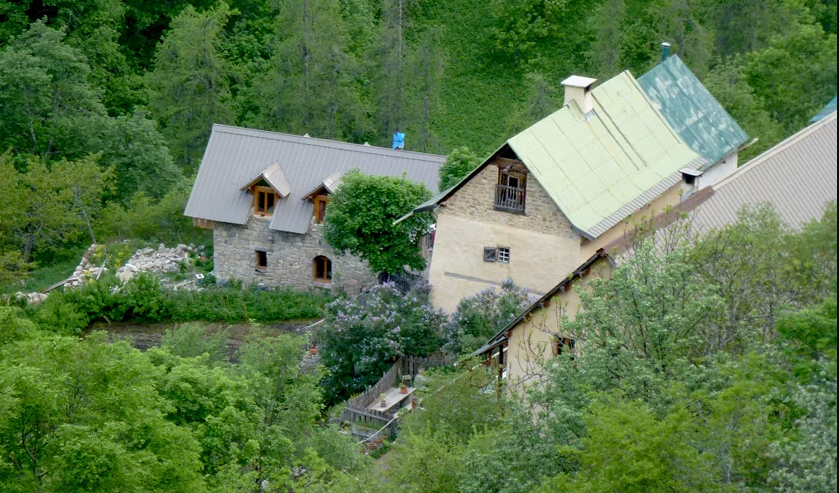
REFUGE DE LA CAYOLLE : Night 5
At an altitude of 2266 m, this authentic mountain refuge offers panoramic views and a peaceful atmosphere. An experience under the stars and in the heart of the Mercantour Alps.

ACCOMMODATIONS OF THE MERCANTOUR CIRCUIT IN PAS DE LOUP
AUBERGE DE SAUZE : Day 1
A picturesque communal inn with stunning views of the high valley of the Var.

CHEZ GUYLAINE, HAMEAU DES TOURRES , Day 2 and 3
A warm welcome in a hamlet perched 1650 m, offering an authentic experience.

A picturesque village with secret alleys and a hotel steeped in history.

HOTEL « LE CHASTELLAN » IN VALBERG .Day 5
Back to civilization with a beautiful terrace in Valberg, family run and renowned for its quality.
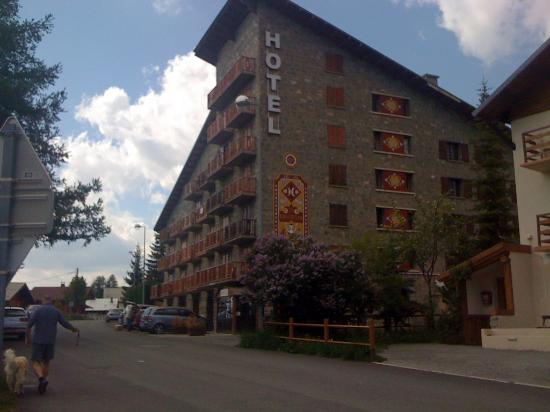
Welcome stop in the charming village of Guillaumes with local cuisine.
What to expect from the donkey trail?
Advice and Information
Hiking with a donkey in the wilderness offers a unique experience, although without a guide, where you go your donkey goes too, your donkey becomes a true companion during these days of adventure. You can share this experience with your family, children or friends. Here are some tips to keep your adventure running smoothly:
Listen carefully: Receive the necessary information to understand your donkey’s behavior, because each animal has its personality, preferences and whims.
Responsibility: A donkey is not just a means of transport, but a living being with needs. Make sure you take care of him and meet his needs.
Donkey character: Often compared to a 4-year-old child, each donkey has its own characteristics. Be prepared to tame and understand your companion.
Evolution of formulas: Bivouac hikes are less and less popular due to changes in public preferences. Most prefer more comfortable accommodation. Bivouac Hazards: Weather and fire hazards have led to the disappearance of bivouac hikes. The unexpected can make these experiences difficult to manage.
Hiking in the wilderness: Opt for the hiking accommodation in accommodation, thus offering the guarantee that all participants are warm and sheltered in the evening.
Choose your plan according to your preference, but be aware of the responsibilities that this entails to ensure a pleasant and secure experience.
How does hiking with a donkey differ from other hikes?
If the idea of escape tickles you, opt for a hike with a donkey this offers a unique experience. Walking at the speed of the donkey creates a special atmosphere, but be ready to familiarize yourself with the thistles on the way. The donkey, lover of wild carrots, will turn you in spite of yourself into an herbalist, unless you have a « firm attitude » from the very start.
Living with a donkey is a very different adventure that requires first of all a love of animals. The donkey quickly becomes a full-fledged member of the group, affectionate, demanding hugs, sometimes jealous, but always at the center of attention. The icing on the cake is that your donkey also takes care of carrying your belongings, freeing you from any painful climbs with a heavy bag on your back. Although the donkey may seem robust, have no doubt his kindness will win you over.
When you arrive in the morning to start your hike, we will take the time to assign you a donkey that corresponds to your profile:
– For families with young children, you will have a sweet and cuddly donkey, ready to receive the cuddles from the little ones and accept the treats.
– For families with teens, we will choose a more energetic mount that can support teen attitude and music and keep up with the family.
We will explain how to take care of the donkey, how to saddle it, along with in depth details about the route. You’ll then meet your new companion for the coming week, do not worry we will always be available to answer your questions via our hotline available during the summer. However, remember that you have chosen a walk in the wilderness, thus showing your will for autonomy and adventure, in the company of an experienced donkey.
A donkey is usually responsible for carrying the luggage of 2 to 4 people, weighing about 30-40 kg. The donkey is equipped with a carrying bag, a halter and a lanyard for holding, as well as bags for luggage. He walks at a regular pace of 3/4 km/h.
In the morning in his park it is recommended to approach the donkey calmly, to speak gently and possibly give him a treat. Putting on the halter can be a challenge at first, but it is advisable to do it smoothly by holding both ends to put the muzzle on while holding the donkey’s head with your arm.
Before loading the luggage, it is essential to brush the donkey to remove dust and grass blades that could cause irritation during the hike. The donkey’s blanket should also be checked to ensure it is clean and dry, without twigs or dirt. The blanket is placed on the donkey’s back, making sure that the wood of the pack is not directly in contact with the donkey’s fur to avoid injuries by friction.
The pack is then positioned behind the withers and held in place by the webbing of the subbelly. It is crucial to tighten this strap properly to prevent the load from tipping over. The other straps are used to adjust the pack to stay in place during steep descents or climbs. The tightening process should be done gradually with regular checking of the position and tension of and on the straps.
How to treat your donkey?
During our recommendations session, we share with you the necessary explanations making sure that you do not leave without having had all our care and health advice. We shall also provide a minimal veterinary pharmacy with a healing spray, an ointment for the fur, a natural anti-fly treatment etc.
How to pack your stuff on the donkey?
It is important to properly organize the load on the donkey before a hike as the donkey’s back is not comparable to a car trunk. Everything must fit in two military bags on each side of the donkey. These are solid pockets called « ensaris ».
A load cell is provided to properly balance the load. which leads us to the dilemma of having to choose the essential items, excluding unnecessary nor vital objects. It is recommended that the children’s favorite toy be placed at the top of the load on the back of the donkey, like a lookout!
Is it not too difficult to leave for a week with the children?
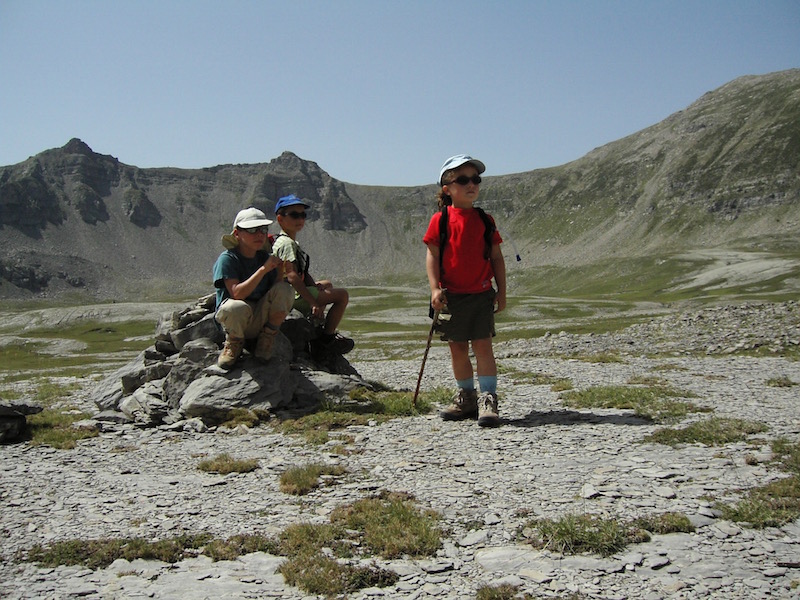
Going on holiday with children for a week is not an impossible mission, especially with our donkeys. The first two days can be a bit demanding on your muscles and the general re- adaptation, but rest assured, no one comes back tired. Thanks to our donkeys, along with stops in the rapids and encounters with wildlife this all makes every day an exciting adventure.
When registering, you have the option to choose between 3 or 7 days of hiking, although this impacts the route if you shorten it. Our course starts at 1200 m and peaks at 2800 m. Although few people have ever given up on the course, it is crucial to understand that your children will walk most of the time, alternating between 4 to five and a half hours per day, with gradients of 400 to 700 m depending on the day.
The possibility of riding on the donkey is occasional, depending on the width of the trails. We favour wild and uncrowded paths, because this is where the donkey offers solid support. Our holidays offer a unique educational experience reconnecting children with the wilderness.

